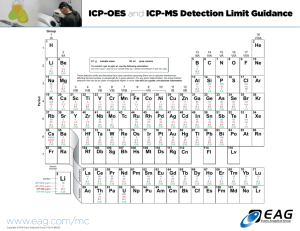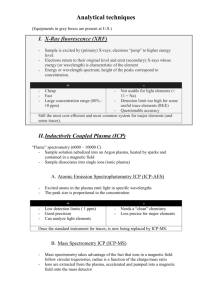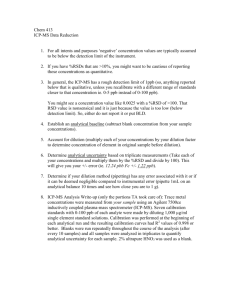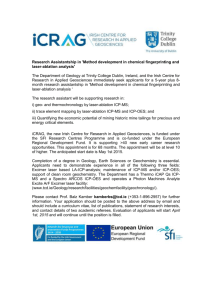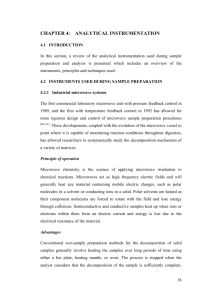A Commercial Analytical Laboratory
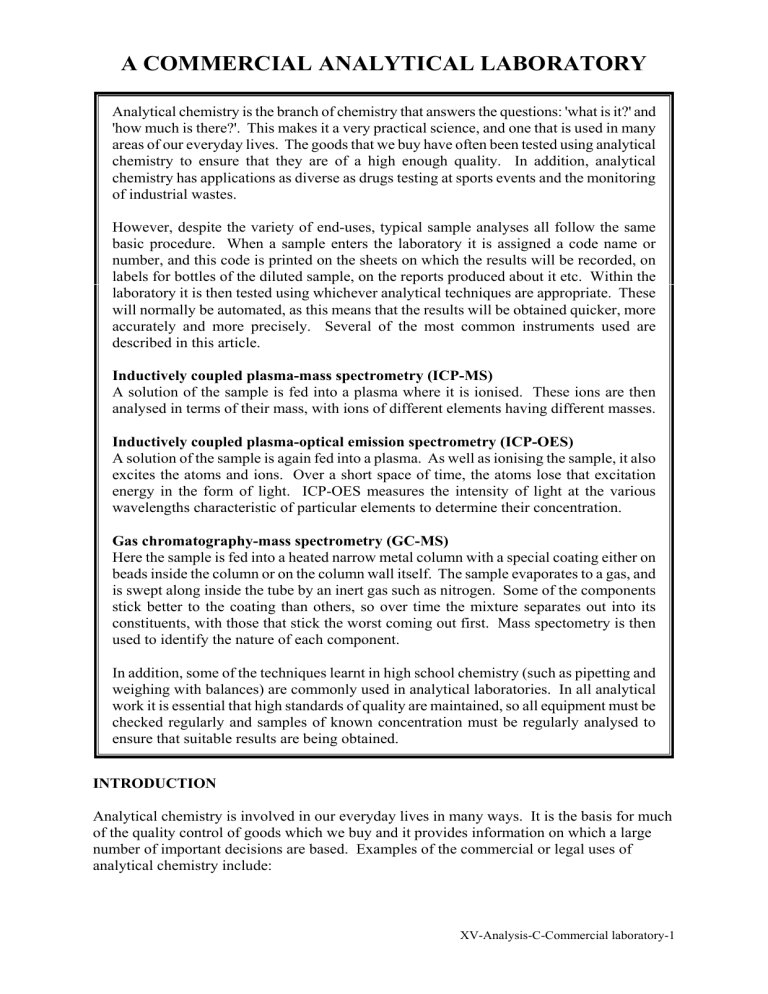
A COMMERCIAL ANALYTICAL LABORATORY
Analytical chemistry is the branch of chemistry that answers the questions: 'what is it?' and
'how much is there?'. This makes it a very practical science, and one that is used in many areas of our everyday lives. The goods that we buy have often been tested using analytical chemistry to ensure that they are of a high enough quality. In addition, analytical chemistry has applications as diverse as drugs testing at sports events and the monitoring of industrial wastes.
However, despite the variety of end-uses, typical sample analyses all follow the same basic procedure. When a sample enters the laboratory it is assigned a code name or number, and this code is printed on the sheets on which the results will be recorded, on labels for bottles of the diluted sample, on the reports produced about it etc. Within the laboratory it is then tested using whichever analytical techniques are appropriate. These will normally be automated, as this means that the results will be obtained quicker, more accurately and more precisely. Several of the most common instruments used are described in this article.
Inductively coupled plasma-mass spectrometry (ICP-MS)
A solution of the sample is fed into a plasma where it is ionised. These ions are then analysed in terms of their mass, with ions of different elements having different masses.
Inductively coupled plasma-optical emission spectrometry (ICP-OES)
A solution of the sample is again fed into a plasma. As well as ionising the sample, it also excites the atoms and ions. Over a short space of time, the atoms lose that excitation energy in the form of light. ICP-OES measures the intensity of light at the various wavelengths characteristic of particular elements to determine their concentration.
Gas chromatography-mass spectrometry (GC-MS)
Here the sample is fed into a heated narrow metal column with a special coating either on beads inside the column or on the column wall itself. The sample evaporates to a gas, and is swept along inside the tube by an inert gas such as nitrogen. Some of the components stick better to the coating than others, so over time the mixture separates out into its constituents, with those that stick the worst coming out first. Mass spectometry is then used to identify the nature of each component.
In addition, some of the techniques learnt in high school chemistry (such as pipetting and weighing with balances) are commonly used in analytical laboratories. In all analytical work it is essential that high standards of quality are maintained, so all equipment must be checked regularly and samples of known concentration must be regularly analysed to ensure that suitable results are being obtained.
INTRODUCTION
Analytical chemistry is involved in our everyday lives in many ways. It is the basis for much of the quality control of goods which we buy and it provides information on which a large number of important decisions are based. Examples of the commercial or legal uses of analytical chemistry include:
XV-Analysis-C-Commercial laboratory-1
•
Quality control of drugs, drenches and medicines, e.g. the monitoring of selenium levels in animal drenches
•
•
•
•
•
Trade waste monitoring for Resource Consents
Drug testing of athletes
Tracking the source of oil spills from ships
of contamination levels from industrial sites, e.g. the determination of
copper, chromium and arsenic at timber treatment plants
•
•
Calculation of nutritional quality of animal feeds
Determination of trace elements in, for example, kiwifruit leaves so fertiliser requirements can be calculated
•
•
•
•
•
Fertiliser and other industrial chemical quality control
Pesticide residue analysis on export fruit crops such as persimmons and strawberries
Proof of identity for drugs seized by police
Blood alcohol analysis
Monitoring of occupational exposure to solvents (important for people such as car spray painters and printers)
It is common to divide commercial laboratories into several divisions, so that staff can become specialists in a particular area of work. For example, Hill Laboratories have divided their chemical analysis laboratory into three: Environmental, Soil & Plant and Food &
Industrial. These divisions are each used by different clientele, reflecting the range of people who use analytical chemical techniques:
Environmental: Local and regional councils
Consultants
Industry
Private citizens
Soil & Plant: Fertiliser company representatives
Farmers
Horticulturists
Gardeners
Food & Industrial: Industry
Private citizens
In addition, the large volume of samples mean that systems need to be set in place so that staff do not lose track of particular samples (i.e. have results but not know which sample they belong to). For this reasons, accredited laboratories are required to have a Laboratory
Information Management System or LIMS . A LIMS System is used for registering samples into the laboratory, maintaining a list of tests to be carried out on the samples, storing the results, producing the final reports and for invoicing the clients for the work done.
The most important thing in any analysis is that the laboratory produces reliable results at a reasonable price, remembering that it is possible that all the analysts involved in producing a
1 Note that, in analytical chemistry, to 'determine' something is to identify what it is, and find out how much of it is there
XV-Analysis-C-Commercial laboratory-2
result may be called upon to defend their work in a court of law. This has been one of the driving forces towards increasing use of instruments and computers, as this both speeds up analysis time and increases reliability. The work of a technician now often involves instrument running and maintenance, quality control and computer work, with laboratory assistants carrying out the more routine tasks.
SAMPLE ANALYSIS
Each sample as it enters the laboratory is given a unique identity code. It is then analysed, and the analysts calculations checked by another person in the laboratory. The results are then entered into the LIMS system, a report printed and checked then rechecked, signed and delivered to the client. A summary of the process is given in Figure 1 .
The tests to be done when the sample is released to the lab depend, of course, on the sample being analysed and the substance being analysed for. Some of the analyses are carried out using only pipettes, burettes, balances etc, but in a modern laboratory most analyses are done using instruments, commonly automated ones, at some stage (see Table 1 ). Brief descriptions of some of these instrumental techniques are given in the following sections.
Inductively coupled plasma-mass spectrometry (ICP-MS)
The term "inductively coupled plasma" refers to the argon plasma formed when a stream of argon gas is passed into a radio frequency (Rf) field. The electrons are stripped from the argon to form a "plasma" with a temperature of around 8000 o
C. A solution of sample is introduced into the plasma, via.
a nebuliser which removes most of the solvent. The compounds in the sample are broken down into individual atoms of the elements present.
Most elements (over 75% of the periodic table) are ionised at the very high temperatures reached in the plasma.
In ICP-MS the ions formed in the argon plasma pass through a small hole in a cone into a region of high vacuum. There they are focussed by a series of electrostatic lenses into an ion beam. This beam then passes into a quadrupole mass analyser, and the ions are separated
according to their mass to charge ratio
m / z ). The quadrupole rapidly scans rapidly scans the mass range of interest - typically 3-250 m / z . The intensity of ions of each mass (i.e. their relative proportion) is measured by an electron multiplier. The ion sample is accumulated and then transferred to the on-line computer for further dat a manipulation by the software.
This technique is extremely sensitive (detection limits can be in parts per trillion range for many elements), but it is affected by two main interferences: interelement and polyatomic.
Interelement interferences occur when two different elements have isotopes of the same mass, while polyatomic interferences occur when two atoms have combind to form an ion with the same mas number as an individual element. The latter is especially important as it means that analyses can be very matrix dependent. For example, high carbon levels will interfere with chromium determinations - A r
(C) = 12, A r
(Ar) = 40 (from plasma), 40 + 12 =
54 = A r
(Cr). Similarly chlorine (35) and argon (40) interfere with arsenic (75).
2 This means that a sodium ion will have a m / z = 23/1 = 23, while a calcium ion will have m / z =
40/2 = 20. Most ions have a charge of only +1 under operating conditions.
XV-Analysis-C-Commercial laboratory-3
Sample received
Assigned ID number
Details entered into LIMS return for correction
Coversheet printed disagreement
Checked against details sent by client agreement
Released to laboratory
Worksheet for test generated
Recalculate not OK
Test carried out
Calculations checked by senior technician
OK
Results entered into LIMS QC data recorded
Yes
More tests?
No
Report generated not OK not OK
Checked by senior technician
OK
Checked and signed by senior manager
OK
Invoice generated
Report sent to client by mail
(possibly also by fax, email or on disc)
Figure 1 - Summary of data flow in an analytical laboratory
XV-Analysis-C-Commercial laboratory-4
Table 1 - Some instuments commonly used in analytical chemistry
Instrument emission spectrometer
Flame atomic absorption
Inductively coupled plasma - mass spectrometer
Inductively coupled plasma - optical
Abbreviation
ICP-MS
ICP-OES
Use
Low level metals
Metals spectrophotometer
AAS)
Graphite furnace atomic absorption spectrometer
Hydride generation atomic absorption spectrometer
Cold vapour atomic absorption spectrometer
Autoanalysers
GFAAS
HAAS
CVAAS
Low level metals
Arsenic and selenium
Mercury ammonia, phosphate,nitrate/nitrite
Flow injection analysis FIA ammonia,
Autotitrator
Gas chromatograph - mass selective detector
Gas chromatograph - flame ionisation detector
Gas chromatograph - electron capture detector/nitrogen/phosphores detector
GC-MS
(or GC-MSD)
GC-FID
GC-ECD/NDP chloride,phosphate,nitrate/nitrite chloride, pH, alkalinity, conductivity
organics (eg. PAH, PCB, drugs) pesticides (detects chloroinated, nitrogen and phosphorus compounds)
Total organic carbon analyser
High performance liquid chromatography
Spectrophotometer
TOC
HPLC organics (eg. pesticides, drugs)
Figure 2 depicts a simple diagrammatic view of an ICP-MS.
ICP-MS is commonly used to analyse for metals such as As, B, Cd, Cr, Mn, Ni, Pb, U, V and
Zn, and many others down to ppb (µg/L) levels in water and sub-ppm (mg/kg) levels in soils, sludges, shellfish, plant tissues, etc.
Inductively coupled plasma-optical emission spectrometry (ICP/OES)
This technique is very similar to ICP-MS in terms of sample introduction, nebulisation and the argon plasma. In ICP-MS, however, the main function of the plasma is to ionise the atoms, while in ICP-OES, its main function is to 'excite' the outer shell electrons in atoms to
XV-Analysis-C-Commercial laboratory-5
Figure 2 - An ICP MS instrument higher energy levels. As they lose excitation energy, they give off light of characteristic wavelengths. The light is focussed and the wavelengths separated by passing it through a prism and diffraction grating as shown in Figure 3.
All the wavelengths may be detected and quantitated simultaneously, so many elements can be determined at the same time.
At Hill Laboratories, ICP-OES is used to determine major cations and metals (Ca, Mg, Na,
K, Fe, Mn), as well as S, P, Si and many other elements. A wide range of samples can be analysed, including waters, soils, sludges, plant tissues, milk powders, etc. The detection limits achievable by ICP-OES are not as low as for ICP-MS, but it is possible to determine elements with ICP-OES which ICP-MS cannot analyse reliably. This is why sulphur, phosphorus and silicon are commonly analysed by ICP-OES rather than ICP-MS.
The main problem in ICP-OES is that each element emits many wavelengths. Sometimes these wavelengths interfere with those of other elements, making it difficult to quantitate these. Iron commonly interferes with the determination of other elements in this way.
Gas Chromatography and Mass Spectrometry (GC-MS)
Gas Chromatography (GC) is a technique used to separate out components in a mixture, and mass spectrometry (MS) is an identification technique. Gas chromatography typically involves injecting 0.1-1 µL of a sample into an injection port heated to 250 C. All components in the sample evaporate almost instantly. They are then swept through a narrow tube (the 'column', typically 30 m long by 0.3 mm ID) by an inert gas (usually helium), and separated on the basis of how well they dissolve in the stationary phase which is coated on the inside of the column. The stationary phase is similar to a silicone oil, and changing the chemistry of the phase can make the column 'selective' towards certain types of compounds,
XV-Analysis-C-Commercial laboratory-6
Figure 3 - An ICP-OES instrument thus improving separations. Modern capillary columns allow the separation of several hundred compounds in one analytical run ( Figure 4 ).
Figure 4 - Total ion chromatograph of a soil extract
As compounds elute from the GC column they can be detected by any of a great variety of techniques. The most specific of these is mass spectrometry, as this gives unique results for almost any compound conceivable. This technique involves passing the column eluent into a mass spectrometer where they are bombarded by a stream of electrons. These knock electrons off the compound molecules, producing positive ions. These ions then fragment and rearrange in ways which are very specific to the individual compound. The positive ions and their break-down products are then separated in a magnetic field to produce a "Full Scan
Mass Spectrum". The mass spectrum for 3,3,5-trimethylcyclohexanone is illustrated in
Figure 5 .
XV-Analysis-C-Commercial laboratory-7
Figure 5 - Mass spectrum of 3,3,5-trimethylcyclohexanone ( "X" in figure 4)
Gas chromatography-mass spectrometry (GC-MS) is arguably the most powerful analytical technique available for organic analysis. It is the technique used at the Olympic Games for drug screening and is now widely used in the analysis of environmental samples because of its specificity, selectivity and sensitivity. It is quite a time consuming technique (a typical
GC-MS analysis would take 30 - 60 minutes) and generates a tremendous amount of data.
Typically the mass spectrum is collected 2 - 10 times per second, and each spectrum shows the signal intensity for every mass unit between 33 and, say, 600. Thus a powerful computer is essential to analyse the results of such a determination.
The nature of the compounds separated out is then determined from the mass spectrum either by comparing the spectrum with those in a spectrum library, or by manually inspecting the spectrum. The NIST has a computerised library of 75 000 compounds, HP has a pesticide library of 350 compounds and laboratories also build up their own libraries over time.
Compounds are still frequently found that are not in these libraries, and in these cases the structure must be determined by figuring out possible structures for fragments of the various masses shown and determining how they could fit together to give a possible structure for the compound.
A technique which has similar selectivity, but generates less data is Selected Ion Monitoring
(SIM). In this technique, the detector is focussed on only a small number of ions (typically 2 or 3 for each compound), rather than scanning the entire spectrum from 33 to 600. For example, the sample in Figure 4 has an ion at mass 120. It can be seen from Figure 6 that simply monitoring this ion gives a much simpler chromatogram.
Advantages of SIM
There are two main advantages to SIM MS. Firstly, as the detector can spend more time measuring at the specific ion masses there is an increase in sensitivity, typically 20 to 100 times. The second advantage is that compounds which do not produce the particular SIM ions in their mass spectrum will not be detected and so the chromatogram is less complex.
XV-Analysis-C-Commercial laboratory-8
Figure 6 - Selected ion monitoring GCMS for mass 120
Thus Full Scan GC-MS gives a high degree of confidence in the qualitative assignment of peaks to compounds. Compounds which are not available as standards or are not in one of the available libraries can often be identified from their mass spectra, so this is a good technique to use for scanning "unknown" samples and when detection limits are not critical.
In addition, the full mass spectrum allows tentative identifications of compounds to be given, whereas SIM GC-MS only says whether or not a suspected compound is present. There is also a lower degree of confidence in qualitative identification. It has the advantage, however, of providing lower detection limits and less matrix interference. Examples of analyses carried out using SIM are polycyclic aromatic hydrocarbons (PAH), polychlorinated biphenyls (PCB) and organochlorine pesticide (OCP) analyses.
PRACTICAL TECHNIQUES
There are a wide range of different techniques which must be mastered by those working in a chemical testing laboratory. The reliability of results being produced is dependent on all practical tasks being carried out both accurately and precisely ( Figure 7 ).
Figure 7 - The difference between accuracy and precision
XV-Analysis-C-Commercial laboratory-9
All results achieved must be both consistent (i.e. precise) and an accurate reflection of the true concentration of that component in the supplied sample. To achieve this, staff must be adept at a variety of practical techniques, the most common of which are:
Weighing with balances . Used for the preparation of reagents and calibrating standards, gravimetric tests such as %w/w dry matter, and the test for suspended solids.
Pipetting . Used for aliquoting samples, diluting, making standards.
Titrations . Used in tests for chloride, alkalinity and acidity.
Employee grades
A typical analytical laboratory employs people with a wide range of qualifications ranging from people straight from school with no qualifications (usually called "Laboratory
Assistants") right through to those with PhD degrees and many years of experience.
Technicians typically have NZCS, BSc, BTech or MSc degrees, and are assisted by unqualified staff.
These people are supervised by people with experience in a particular area of laboratory work who also have tertiary qualifications, typically at masters or PhD level.
QUALITY CONTROL
As in all chemical industries, quality control is of great importance. In an analytical laboratory, the results are usually required as part of someone else's quality control procedure or for legal reasons such as environmental monitoring. It is thus very important both from a
•
• financial and a legal point of view that the results are both very accurate and very precise.
These high standards of quality control are achieved through checking in different ways and at many stages throughout each analysis as follows (also see Figure 1 ):
•
•
All work is checked at least once by a senior technician
“Blanks” are analysed with each batch of samples to check for contamination, reagent function, etc.
Samples may be analysed in replicate ie several times
Samples may be “spiked” with the analyte at a known level and a recovery % calculated.
•
Standard (or Certified) Reference Materials are analysed along with the samples.
These are materials for which the analyte concentration is already known, so they give an indication of the accuracy of the technique used.
•
In-house Quality Control (QC) samples are often analysed with each batch of samples.
Laboratories in New Zealand are usually accredited by IANZ (International Accreditation
New Zealand), to an international laboratory standard called Guide 25. IANZ regularly inspect all their accredited laboratories to ensure that their work is of a suitable quality. They require that a specific person in the laboratory be in charge of quality control. This person is responsible for ensuring that equipment calibration is carried out at the right time, that all documentation is up-to-date, etc.
XV-Analysis-C-Commercial laboratory-10
Thus commercial analytical laboratories provide a valuable service to a wide range of people in the community, and carry out environmental testing work from which everyone benefits.
Because of the important legal and financial implications of their work, many instruments are used to improve the speed, accuracy and precision of analyses, and systems are in place to ensure that only high quality work is released to clients.
Written by Peter Robinson, R J Hill Laboratories Ltd., Hamilton.
XV-Analysis-C-Commercial laboratory-11
